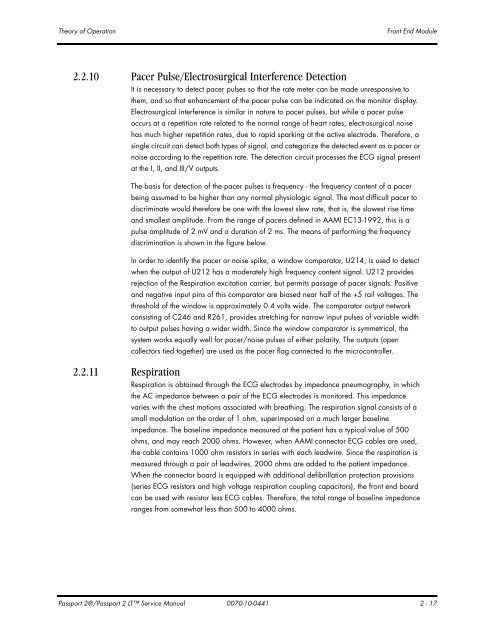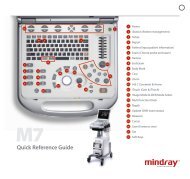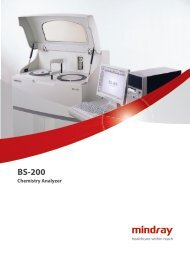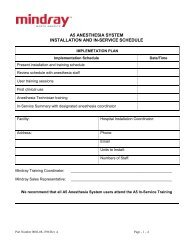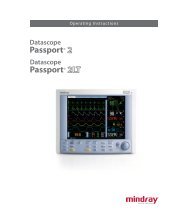Datascope Passport - Mindray
Datascope Passport - Mindray
Datascope Passport - Mindray
You also want an ePaper? Increase the reach of your titles
YUMPU automatically turns print PDFs into web optimized ePapers that Google loves.
Theory of Operation Front End Module<br />
2.2.10 Pacer Pulse/Electrosurgical Interference Detection<br />
2.2.11 Respiration<br />
It is necessary to detect pacer pulses so that the rate meter can be made unresponsive to<br />
them, and so that enhancement of the pacer pulse can be indicated on the monitor display.<br />
Electrosurgical interference is similar in nature to pacer pulses, but while a pacer pulse<br />
occurs at a repetition rate related to the normal range of heart rates, electrosurgical noise<br />
has much higher repetition rates, due to rapid sparking at the active electrode. Therefore, a<br />
single circuit can detect both types of signal, and categorize the detected event as a pacer or<br />
noise according to the repetition rate. The detection circuit processes the ECG signal present<br />
at the I, II, and III/V outputs.<br />
The basis for detection of the pacer pulses is frequency - the frequency content of a pacer<br />
being assumed to be higher than any normal physiologic signal. The most difficult pacer to<br />
discriminate would therefore be one with the lowest slew rate, that is, the slowest rise time<br />
and smallest amplitude. From the range of pacers defined in AAMI EC13-1992, this is a<br />
pulse amplitude of 2 mV and a duration of 2 ms. The means of performing the frequency<br />
discrimination is shown in the figure below.<br />
In order to identify the pacer or noise spike, a window comparator, U214, is used to detect<br />
when the output of U212 has a moderately high frequency content signal. U212 provides<br />
rejection of the Respiration excitation carrier, but permits passage of pacer signals. Positive<br />
and negative input pins of this comparator are biased near half of the +5 rail voltages. The<br />
threshold of the window is approximately 0.4 volts wide. The comparator output network<br />
consisting of C246 and R261, provides stretching for narrow input pulses of variable width<br />
to output pulses having a wider width. Since the window comparator is symmetrical, the<br />
system works equally well for pacer/noise pulses of either polarity. The outputs (open<br />
collectors tied together) are used as the pacer flag connected to the microcontroller.<br />
Respiration is obtained through the ECG electrodes by impedance pneumography, in which<br />
the AC impedance between a pair of the ECG electrodes is monitored. This impedance<br />
varies with the chest motions associated with breathing. The respiration signal consists of a<br />
small modulation on the order of 1 ohm, superimposed on a much larger baseline<br />
impedance. The baseline impedance measured at the patient has a typical value of 500<br />
ohms, and may reach 2000 ohms. However, when AAMI connector ECG cables are used,<br />
the cable contains 1000 ohm resistors in series with each leadwire. Since the respiration is<br />
measured through a pair of leadwires, 2000 ohms are added to the patient impedance.<br />
When the connector board is equipped with additional defibrillation protection provisions<br />
(series ECG resistors and high voltage respiration coupling capacitors), the front end board<br />
can be used with resistor less ECG cables. Therefore, the total range of baseline impedance<br />
ranges from somewhat less than 500 to 4000 ohms.<br />
<strong>Passport</strong> 2®/<strong>Passport</strong> 2 LT Service Manual 0070-10-0441 2 - 17


